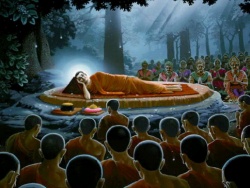Twenty-four successors
twenty-four successors
[付法蔵の二十四人] (Jpn fuhozo-no-nijuyo-nin )
Also, twenty-four patriarchs. Those who, after Shakyamuni Buddha's death, successively inherited the lineage of his teachings and propagated them in India. According to A History of the Buddha's Successors, there are twenty-three successors of the Buddha.
They are:
(1) Mahakashyapa,
(2) Ananda,
(3) Shanavasa,
(4) Upagupta,
(5) Dhritaka, (
(6) Mikkaka,
(7) Buddhananda,
(8) Buddhamitra,
(9) Parshva,
(10) Punyayashas,
(11) Ashvaghosha,
(12) Kapimala,
(13) Nagarjuna,
(14) Aryadeva,
(15) Rahulabhadra (also Rahulata),
(16) Samghanandi,
(17) Samghayashas,
(18) Kumarata,
(19) Jayata,
(20) Vasubandhu,
(21) Manorhita,
(22) Haklenayashas, and
(23) Aryasimha.
The above work states that Ananda transferred the Buddha's teachings to both Madhyantika and Shanavasa.Madhyantika propagated them in Kashmir but had no known successor.Shanavasa transferred the Buddha's teachings to Upagupta, from whom the Buddha's teaching was finally passed on to Aryasimha without inter-mittence.
Based on this view, the Chinese priest Chang-an (561-632), T'ient'ai's successor, while listing the twenty-three successors in his preface to T'ient'ai's Great Concentration and Insight, went on to state that Madhyantika and Shanavasa were contemporaries who both inherited the Buddha's teachings from Ananda. Therefore, if both are included among the Buddha's successors, he pointed out, there are twenty-four. Among the twenty-four successors, Madhyantika is regarded as the third and Shanavasa as the fourth. Chang-an's statement led the T'ient'ai school to adopt this view of twenty-four successors, in addition to the traditional view of twenty-three.
